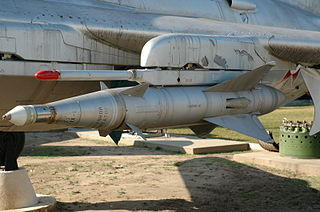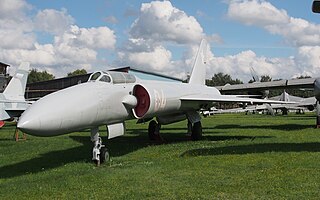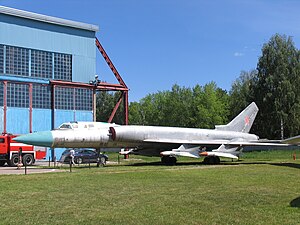
The Mikoyan-Gurevich MiG-19 is a Soviet second generation, single-seat, twinjet fighter aircraft and was the world's first mass-produced supersonic aircraft. It was the first Soviet production aircraft capable of supersonic speeds in level flight. A comparable U.S. "Century Series" fighter was the North American F-100 Super Sabre, although the MiG-19 primarily fought against the more modern McDonnell Douglas F-4 Phantom II and Republic F-105 Thunderchief over North Vietnam. This aircraft was originally used by the Soviet Union but it was later used by the People's Liberation Army Air Force of China.

An interceptor aircraft, or simply interceptor, is a type of fighter aircraft designed specifically for the defensive interception role against an attacking enemy aircraft, particularly bombers and reconnaissance aircraft. Aircraft that are capable of being or are employed as both ‘standard’ air superiority fighters and as interceptors are sometimes known as fighter-interceptors. There are two general classes of interceptor: light fighters, designed for high performance over short range; and heavy fighters, which are intended to operate over longer ranges, in contested airspace and adverse meteorological conditions. While the second type was exemplified historically by specialized night fighter and all-weather interceptor designs, the integration of mid-air refueling, satellite navigation, on-board radar and beyond visual range (BVR) missile systems since the 1960s has allowed most frontline fighter designs to fill the roles once reserved for specialised night/all-weather fighters.

The Mikoyan-Gurevich MiG-25 is a supersonic interceptor and reconnaissance aircraft that is among the fastest military aircraft to enter service. Designed by the Soviet Union's Mikoyan-Gurevich bureau, it is an aircraft built primarily using stainless steel. It was to be the last plane designed by Mikhail Gurevich, before his retirement.

The Mikoyan MiG-31 is a supersonic interceptor aircraft developed for the Soviet Air Forces by the Mikoyan design bureau as a replacement for the earlier MiG-25 "Foxbat"; the MiG-31 is based on and shares design elements with the MiG-25.

The Tupolev Tu-16 is a twin-engined jet strategic heavy bomber used by the Soviet Union. It has been flown for almost 70 years, and the Chinese license-built version Xian H-6 remains in service with the People's Liberation Army Air Force, with more being built as of 2020.

The Sukhoi Su-15 is a twinjet supersonic interceptor aircraft developed by the Soviet Union. It entered service in 1965 and remained one of the front-line designs into the 1990s. The Su-15 was designed to replace the Sukhoi Su-11 and Sukhoi Su-9, which were becoming obsolete as NATO introduced newer and more capable strategic bombers.

The North American XF-108 Rapier was a proposed long-range, high-speed interceptor aircraft designed by North American Aviation intended to defend the United States from supersonic Soviet strategic bombers. The aircraft would have cruised at speeds around Mach 3 with an unrefueled combat radius over 1,000 nautical miles, and was equipped with radar and missiles offering engagement ranges up to 100 miles (160 km) against bomber-sized targets.

The Yakovlev Yak-25 was a swept wing, turbojet-powered interceptor and reconnaissance aircraft built by Yakovlev and used by the Soviet Union.

The Tupolev Tu-98 was a prototype swept wing jet bomber developed by Tupolev for the Soviet Union.

The Kaliningrad K-5, also known as RS-1U or product ShM, was an early Soviet air-to-air missile.

The Kaliningrad K-8 (R-8) was a medium-range air-to-air missile developed by the Soviet Union for interceptor aircraft use.

The Tupolev Tu-14, was a Soviet twinjet light bomber derived from the Tupolev '73', the failed competitor to the Ilyushin Il-28 'Beagle'. It was used as a torpedo bomber by the mine-torpedo regiments of Soviet Naval Aviation between 1952–1959 and exported to the People's Republic of China.

The BisnovatR-4 was an early Soviet long-range air-to-air missile. It was used primarily as the sole weapon of the Tupolev Tu-128 interceptor, matching its RP-S Smerch ('Tornado') radar.

The Lavochkin La-250 "Anakonda" was a high-altitude interceptor aircraft prototype developed in the Soviet Union by the Lavochkin design bureau in the 1950s. Its nickname "Anaconda" was invented during the flight test and referred to both the elongated body shape as well as the relatively critical flight characteristics of the machine.

The Raduga Kh-26 KSR-5 was a long-range, air-launched cruise missile and anti ship missile developed by the Soviet Union. It was essentially a scaled down version of the Kh-22 'Kitchen', built to be carried by the less capable Tu-16.

Savatiya is a former Russian Air Force air base in Arkhangelsk Oblast, Russia located 29 km south of Kotlas. It is a small interceptor airfield. It was home to 445th Interceptor Aviation Regiment between 1967 and 1993, which received Tupolev Tu-128 aircraft in 1967, Mikoyan-Gurevich MiG-25 aircraft by the late 1970s, and Mikoyan MiG-31 by the 1990s. It is also listed as being home to 458th Guards Interceptor Aviation Regiment which flew MiG-31s in the 1990s.

The RP-21 Sapfir was a radar system developed by the Soviet Union for use in the updated MiG-21PF fighter, and used in later versions of the MiG-21.

The Mikoyan-Gurevich Ye-150 family was a series of prototype interceptor aircraft designed and built by the Mikoyan-Gurevich design bureau in the Soviet Union from 1955.
Red Hebe was a large active radar homing air-to-air missile developed by Vickers for the Royal Air Force's Operational Requirement F.155 interceptor aircraft. It was a development of the earlier Red Dean, which was not suitable for launch by the new supersonic aircraft. Before progressing much beyond advanced design studies, F.155 was cancelled in the aftermath of the 1957 Defence White Paper which moved Britain's attention from strategic bombers to ballistic missiles. With no other suitable platform, Red Hebe was cancelled as well.





















